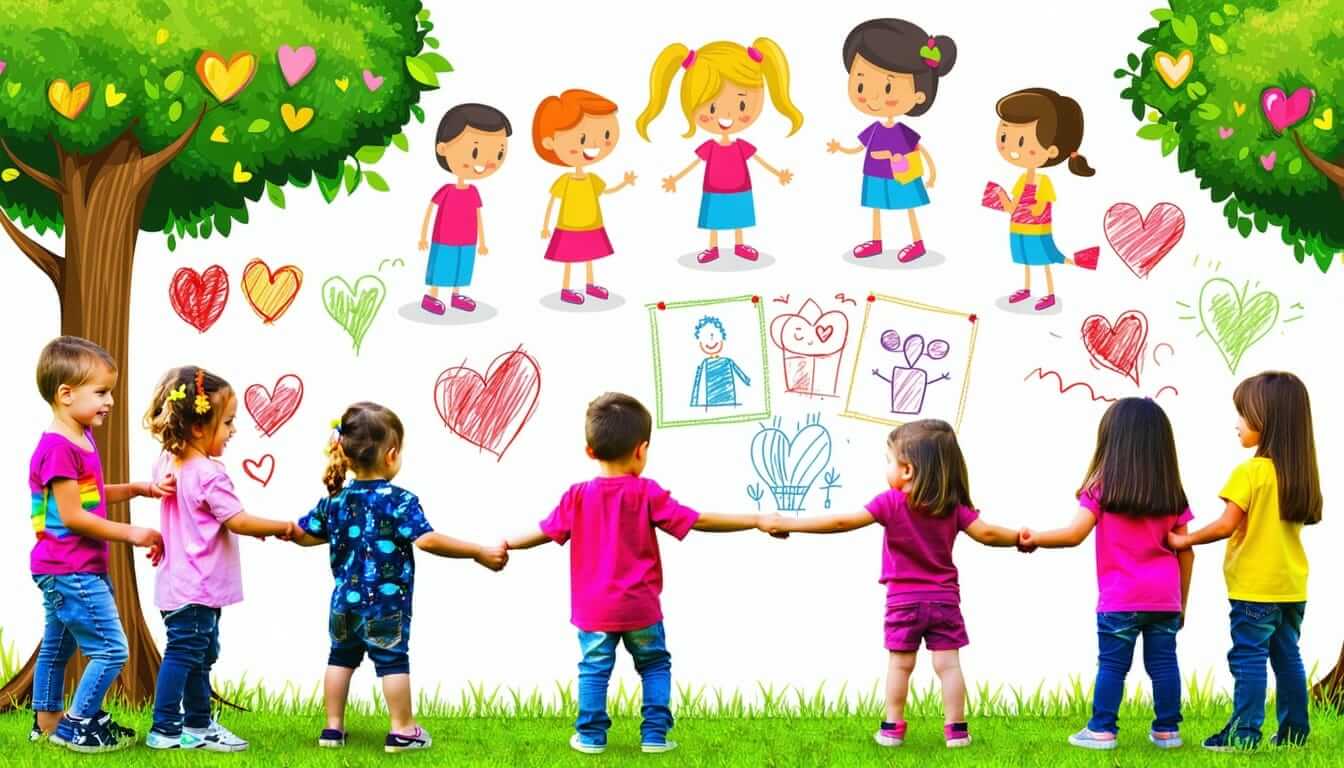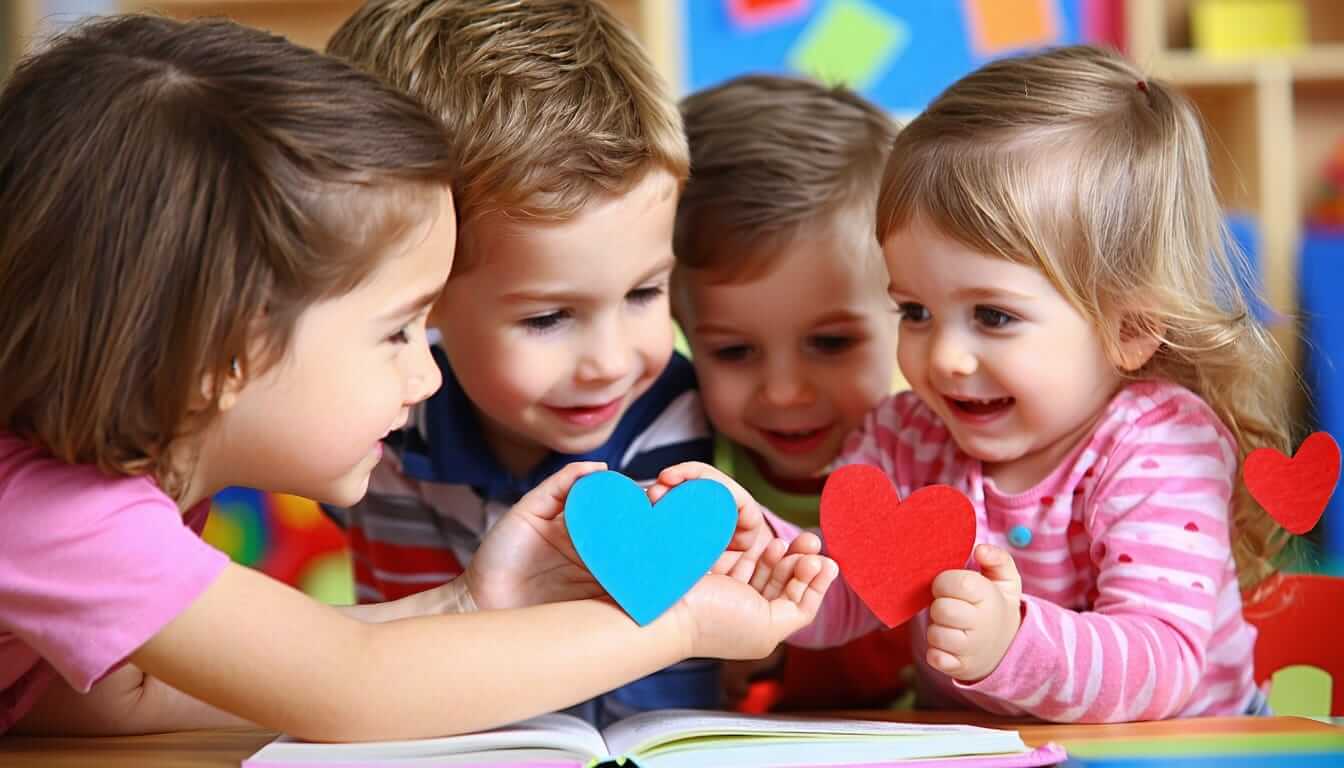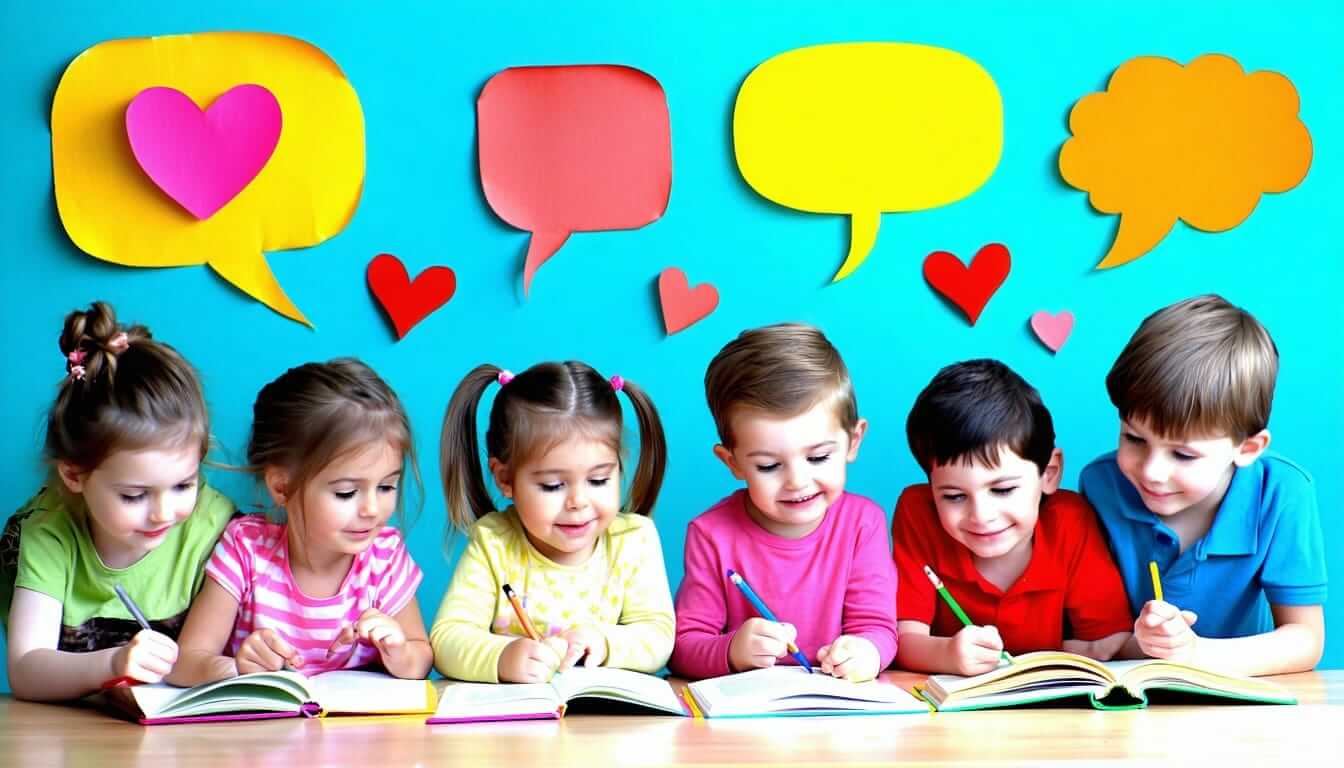Building Respect in Children
Creating an atmosphere of respect kicks off right at home. As a parent, you’re the VIP in nurturing this crucial character trait in your kiddos.
The Role of Parents
Think of yourself as your kid’s first teacher. Your influence is golden when it comes to growing their social skills, emotions, and physical growth. This foundation helps them soar both in school and life. By strutting respectful actions and chatting openly, you’re the DJ setting the beat on how your kid understands and practices respect wherever they go.
Check out some tips to boost respect lessons for your young ones:
| Strategy | Description |
|---|---|
| Active Listening | Let your kiddo get their feelings and thoughts out in the open without you chiming in before they finish. |
| Open Discussions | Stir up some family chats on respect, showing why it matters to see things from all angles. |
| Demonstration | Use respectful words and deeds in your daily grind. Kids copy adults, so give them a front-row seat to respecting others. |
Importance of Family Engagement
Getting the family involved isn’t just a nice-to-have; it’s a game-changer for your kid’s schooling. Research pops up showing that having parents in the mix forecasts school success better than education level, how big your fam is, or your financial status. Families on board often mean clearer and more steady teaching paths, handing kids a beefier learning journey.
Bringing respect-centered activities to family fun time can lock in these lessons with a bang. Check these out:
| Activity | Description |
|---|---|
| Community Service | Jump into volunteering together to grow empathy and give kids a peek into other people’s worlds. |
| Role-Playing | Make learning about respectful responses second nature by acting out situations together. |
| Family Meetings | Keep those regular family pow-wows going to hash out issues or celebrate wins, making room for everyone’s voice and opinion. |
When you jump into these activities, you make a big splash in guiding your child to be both kind and understanding. Look for more tips on instilling respect in kids through our extra goodies.
Zeroing in on respect teachings at home lays the bricks for how they play the game of life, both socially and in the classroom.
Understanding Diversity in Education
Getting kids to value and respect others begins with understanding the awesome mix of cultures and backgrounds in school. It sets up a classroom that’s open, warm, and gets kids thinking in new and exciting ways.
Benefits of Classroom Diversity
A mix of backgrounds in class makes learning way more exciting and gives students crucial life skills. Let’s break it down:
| Benefit | What It Means and Why It Rocks |
|---|---|
| Thinking Skills Boom | Being around different perspectives boosts creative thinking and problem-solving. Diverse groups tend to find better solutions (American University). |
| Ready for the Real World | Experiencing diversity at school gets students ready for jobs where teamwork across different backgrounds is key – 96% of big employers agree. |
| Empathy and Openness | Meeting folks from various walks of life makes students more caring and able to see things from different angles (Drexel University School of Education). |
| Welcoming Classes | Knowing about each other’s cultures builds a classroom where everyone feels they belong, super important for learning (Drexel University School of Education). |
Fostering Cultural Awareness
Understanding different cultures is a big deal for both students and teachers. It’s about making everyone feel like they’re part of the crew and readying students for a mixed-up world. Bringing different stories and cultures into lessons can really make waves.
- Building Empathy: Learning about other cultures means students can start to feel what others feel, which helps grow empathy. Check out teaching respect through empathy.
- Safe Space: When different cultures are celebrated, students are more likely to feel comfortable talking about what makes them unique, super important for learning and growing.
- Strong Bonds: Teaching with respect for cultural differences helps students from diverse backgrounds get along better. Dive into some respect activities for kids to keep those good vibes going.
- Lesson Variety: Mixing up lesson materials to include diverse voices gives students a bigger picture of the world, getting them ready for everyday meetings with new ideas and cultures.
When your kid interacts with various cultures, they build social skills and learn to respect others. Check out character building activities for kids to keep these positive values growing in daily life.
Teaching Respect in the Classroom
Teaching respect in schools can brighten up the learning atmosphere. Let’s dive into some handy tricks to help your kid learn to respect their classmates and teachers.
Modeling Respectful Behavior
Parents, you’re up! Being a role model in showing respect is a strong way your child learns. Kids are like sponges – they soak up everything by watching you. So when you engage respectfully in talks, actions, or making decisions, you’re sending a big message about how important these behaviors are.
Here’s a cheat sheet for modeling respect:
| Behavior | How to Show It |
|---|---|
| Say ‘Hello’ with Heart | Use a friendly voice and smile. |
| Eyes on the Prize | Look at people when chatting to show you care. |
| Keep it Upbeat | Talk with a positive spin. |
| Own Up to Your Oops | If you mess up, apologize genuinely. |
Thrive Alliance Group reminds us that simple acts like greeting your child or their pals warmly teaches them the importance of respect. Staying chill in disagreements helps show there’s a better way to handle conflicts than being rude.
Promoting Respectful Interactions
Getting kids to be respectful in class takes a bit of work. If kids learn to share their feelings, think about others, and speak well with others, respect can grow.
Here are some handy tips:
- Understand Empathy: Coach your kid to think about how others feel. Talk about made-up situations and ask how they’d like it if they were in someone else’s shoes. This builds empathy.
- Clear Examples: Use kid-friendly examples of respect—like sharing, waiting their turn, and listening. Chatting about why these are important can help them stick.
- Conflict Guide: Show your child how to handle disagreements the respectful way. Teach them to stay cool, listen first, and respond without sass.
- Kindness Points: Notice and cheer for acts of kindness, like sharing or lending a hand. A small pat on the back or a compliment can go a long way (Thrive Alliance Group).
- Team Up with Teachers: Work with teachers to do group talks or projects that encourage respect. Teamwork builds understanding and cooperation.
These moves can help you spread respect in school and teach your child solid social skills. For more ideas, check out these links on respect activities for kids and teaching respect to children to see how respect can thrive in your child’s everyday life.
Effective Parental Involvement
Being involved in your child’s life is like giving them a special boost. It plays a huge role in shaping how they think, act, and perform in school. By being there for their education, you’re setting them up to grasp life’s important lessons, like respect and good character.
Impact on Academic Achievement
It’s surprising but true: how involved you are matters more for your child’s grades than things like the family’s schooling levels or income. By engaging with their schooling, you’re turning educational programs into power tools, helping everyone communicate better — parents, teachers, the whole gang.
Here’s a little peek at how being involved can pay off for your kid’s school life:
| How You’re Involved | What It Does for Grades |
|---|---|
| Chatting with Teachers | Big boosts in scores |
| Joining School Happenings | Better at social stuff |
| Helping with Homework | They get subjects more |
By teaming up, you’re not just backing up the teaching respect lessons but also building a comfy and happy learning zone. To get more ideas, swing by our page on teaching respect to children.
Collaborating with Schools and Community
Getting along with the school and local groups means your child grows up comfy with different cultures and settings. When these folks come together, it makes a buzzing learning place where respect and understanding come alive.
Jumping into school events or even leading classes can be super engaging for all the kids and show off the mixed cultures at your school. Here’s what makes good teamwork:
| Good Practices | What They Mean |
|---|---|
| Appreciating Family Help | Families pitch in on decisions |
| Respect All Around | Partnerships built on trust and responsibility |
| Keeping Up the Talk | Regular chats between home and school |
By joining forces, schools and parents can whip up ways to foster respect in kiddos, pushing them to become rock-solid, kind-hearted people. Tapping into community resources adds a splash to your kid’s learning adventure, especially where breaking down cultural or language walls is key.
In the end, sticking by your kid’s side through their school years does wonders for their grades and helps shape them into the great humans they’re meant to be.
Cultivating Respect Through Actions
We all know teaching kids respect isn’t just about words. It’s about action—showing empathy, kindness, and some good old social skills in those everyday moments. You’re the captain steering your child towards these values.
Showing Empathy and Kindness
Empathy isn’t just a fancy word to throw around. It’s getting who’s around you and feeling their vibes. You got this by showing your kids the ropes. Listening like you mean it when someone chats or lending a hand to a classmate in trouble creates ripples. Little stuff, like remembering your “pleases” and “thank-yous,” can pack a punch. Make sure to greet people with a smile and trust me, holding the door open is more than just good manners. It’s about creating that warm fuzzy feeling inside Kindergarten Cafe.
Grab some resources for story time like “How to Fill a Bucket” or dive into Howard B. Wigglebottom, both are treasures when sharing the importance of kindness.
| Empathetic Actions | Description |
|---|---|
| Listening Actively | Really hearing someone out; it says, “You matter.” |
| Helping Others | Jumping in when someone needs it, big or small. |
| Using Manners | Simple words like ‘please’ and ‘thank you’ go a long way. |
Boosting Social Emotional Skills
Social emotional skills build the bridge to kindness and respect. Teaching your little one to share, wait their turn, and help out sparks emotional smarts. These skills set the stage for teamwork and compromise, vital in buddy-buddy land Kindergarten Cafe.
Encouraging respect for their classroom and school digs is important. Tidying up, straightening chairs, and putting stuff back in its place show respect and responsibility, keeping things safe and sound Kindergarten Cafe.
Incorporating fun and games through character building activities for kids can be a win. These reinforce respect in enjoyable and meaningful ways. Practicing respect day in and day out sets kids on the path to becoming caring individuals, ensuring they treat others well.
By diving into empathy, kindness, and social emotional skills, you’re crafting an environment where respect lives and breathes. You play the major part in shaping your child’s everyday actions and understanding of respect.
Successful Classroom Programs
Schools cooking up fun programs can make all the difference when teaching kids about respect. Check out what Riverside School’s ROPES program and Oakwood Country School’s Community Service Initiative have whipped up!
Riverside School’s ROPES Program
Riverside School in Connecticut sure turned heads with their ROPES program. What’s the buzz about? Well, it’s about making the school a friendlier place. Teaching kids to value themselves, look after things, and treat mates and their surroundings with respect is what ROPES is all about. And, guess what? This clever program snagged the A+ School Impact Award way back in 2003-04 (Education World).
So, what’s in the ROPES program mix?
- Cool Achievements: Kids showing off the ROPES attitude get rewarded with themed activities. Imagine untying a knot as a cool symbol of their efforts.
- Learning With a Twist: Diving into books, writing poems, and acting out skits pump some fun into learning about respect.
- Jamming Sessions: Song time isn’t just fun; it’s a clever way to teach respect too. Tunes like “Don’t Laugh at Me” and “R-E-S-P-E-C-T” turn lessons into catchy tunes.
One amazing outcome? The program warmed hearts throughout Riverside with a beautiful display of kindness towards a severely disabled student, proving the ROPES values work wonders at breeding acceptance and love (Education World).
Oakwood Country School’s Community Service Initiative
Not one for being outdone, Oakwood Country School in California came alive with their Community Service Initiative, earning the A+ Community Impact Award in 2003-04. It got middle schoolers knee-deep in over 50 service projects, sparking a flame of empathy and caring (Education World).
What’s the initiative all about?
- Service Safari: Kids tackle 50 different projects each term. From gathering goods for shelters to wrapping up holiday cheer for families, they’re truly all in.
- Jumping Into Community Fun: Hands get dirty while painting over graffiti, digging in for a community garden miracle, or cozying up with kiddie books at shelters – all part of building a stronger community spirit.
- Fundraising Feats: The kiddos even managed to rake in $10,000 for the American Cancer Society’s “Relay for Life.” Now that’s showing how to make waves and stir up change.
With Riverside’s ROPES and Oakwood’s Service Initiative stirring up respect and love through hands-on action and genuine community love, sparks of change are flying high. Looking for more ways to sprinkle respect into kids’ lives? Dig into our respect activities for kids and teaching respect to children sections.




